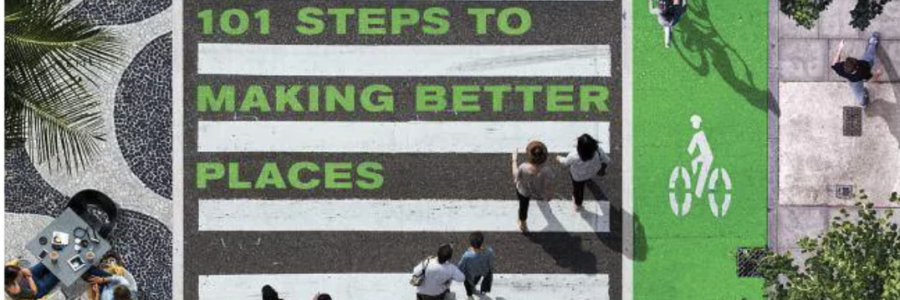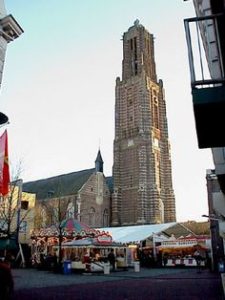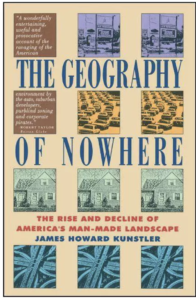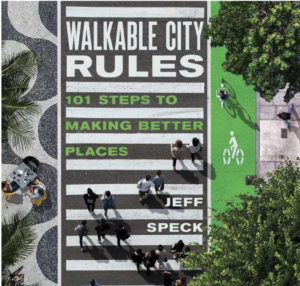
Mixed Signals: the Evolution of Confusing City Mobility
I am going to wax nostalgic for a minute over an existence I am too young to know: the small town, with a town center, full of thriving stores. A place where everyone can and does walk to the store, the post office, the library, or to classes in knitting or to learn other languages. A town with thriving cafes, businesses, a respect for history, and one that provides ample transit connections to other cities. A place where bikes are common and cars share the roads with respect and equanimity.
Oh, wait. I do know this town! I lived there for about 18 months. It is the town of Weert, in the southern part of the Netherlands, about 3 km from the Belgian border. A town with a car-free center, a vibrant weekly market, and many jobs within biking distance.
 I currently live in a small city that could be very much like this town in the Netherlands. From where my family lives we can easily walk to the store, restaurants, the police station, library, tattoo shop, school, and even a dentist office. There is a stage theatre within 1/2 mile and a movie theatre as well. And I am within three miles of my work, with a lovely park on the way. But it is not a pedestrian friendly town, and this totally bums me out. I still walk, but this city does not love its walkers.
I currently live in a small city that could be very much like this town in the Netherlands. From where my family lives we can easily walk to the store, restaurants, the police station, library, tattoo shop, school, and even a dentist office. There is a stage theatre within 1/2 mile and a movie theatre as well. And I am within three miles of my work, with a lovely park on the way. But it is not a pedestrian friendly town, and this totally bums me out. I still walk, but this city does not love its walkers.
Why is it that with all we know about diversity, health, happiness, fitness, and economic resilience, all of which are best supported by walking, we are not a pedestrian friendly city, here, in Albany, NY? And how is it that the town of Weert does this so very well?
To make it simple, and incredibly basic, the answer is the car. The better answer is the active lobby in the USA for the fossil fuel and car industry that even in the 1920’s pushed us into planning that is 1) totally reliant on having a car, and 2) designed for the car to the exclusion of other choices. If you have not yet read “The Geography of Nowhere” by James Howard Kunstler, I highly recommend it.
This is not meanT to blame but to recognize what we need to overcome in the USA if we are to get back to cities for people. And small and mid-sized cities, built for people, are a must in our evolving climate future. I almost typed “cities with complete-streets” but even that term undercuts the real point, calling for us only to build on the existing structure: an existing structure that is designed for cars, not people! Even “multi-modal” isn’t a fair description of what we want and why we want it. We need people-centric planning. Just as we build buildings for people, cities should be built (and altered) for people. Cars should be secondary, and used to subsidize things only when needed. There. I said it.
I walk. I walk a lot, as does my husband. With the dog, on our own, to the stores, or on a 3-4 mile trek to the park and back. I also bike often to work, and sometimes for a journey downtown and then upriver to Troy, NY, to the famous farmer’s market on Saturday. Now, the Troy farmers’ market is truly people-centric, even though it is based on city streets. It is people-centric for the five or so hours of the market because cars are not allowed in that city center for all of that timeframe, once a week, every week. It is so friendly, safe, and popular that I hear they are adding a mid-week market this year.
As a walker, a bicyclist, and a driver, I think I can identify some of the mixed signals that make it hard to co-exist. Some of the confusion comes from the existing situations, and some form the history of changes leading us to the present. First the latter and then the first.
History:
Some of our transition to car-focused living is due to the creation of suburbia, where people HAD to have cars to get to their in-city jobs, so the “communities” were designed primarily to be accessed by cars and to have capacity to store cars. There was no need for stores or community resources, because all that existed in the city and could be accessed during the day. That’s history a bit far back, and a big part of the book I mentioned earlier. Let’s talk about the more recent history of walking in a city.
Cities tend to have sidewalks, and, yes, where there are sidewalks, we are supported. Yet what happens when we get to a crossing?
There was always, when I was a kid, a lot of effort to get people to cross at the corner. At the corner there were often stop signs, or at least a common understanding by drivers that someone may be crossing there. When I walked to school we took our lives into our hands if we choose to cross anywhere but at the corner.
Then crosswalks were added. Some in the center of the blocks where people crossed often, because of the location of certain bigger businesses or a particularly popular store. In Albany, they went so far as to put signs into those mid-block crossing indicating that it is a state law that cars have to stop for pedestrians in crosswalks. Sounds like pedestrians are fully supported, yes?
Pedestrians used to be able to gage their crossing by the traffic signals for the cars, and make their own judgement, staying safely in the crosswalks. This worked well until “right-on-red” became normal. Because the cars can turn right even if their signal is a stop light, they forget that there may be pedestrians that have the right of way due to a crosswalk.
Let’s add some more confusion. For some reason, in order to promote pedestrian safety, the City of Albany added crosswalk signals. By law, if the crossing signal light says “don’t walk” you cannot cross. But what happened to the law that says cars must stop for pedestrians in crosswalks? Oh, well, the law about the crossing signals supersedes that other law, so in reality, a pedestrian is breaking the law if she crosses in a crosswalk if there is a crossing signal that is saying “don’t walk”. Got it? Perfectly clear? Extra points to you, because to be honest most drivers don’t know these laws or the inherent conflicts and few pedestrians do either.
We used to have a perfectly good, center of the block crosswalk on a main downtown street in Albany. The city had a signboard in the crosswalk for a half dozen years, clearly stating that pedestrians in the crosswalks have the right-of-way. And now they have made it even more confusing than adding in walk signals…they have put in “indicator lights” that flash. The pedestrian wishing to cross goes to push the button and the lights begin flashing right away. The button, by the way, is on the left side of the walkway in each direction, which is totally counter to staying to the right, which is how we’ve all been trained to share roads and walkways. There is also now no signboard in the crosswalk. And there is no traffic signal or walk signal, just flashing lights. It is almost as if these lights are the indicator to the drivers that the game is on and they should speed up. It’s as if this crossing is now an in-real-life computer game.
Some places, such as Albany, have chosen “beg buttons” where the pedestrian can request a crossing. From one perspective, this is respectful. From another perspective, this means the cars always have priority, unless someone specifically requests permission to cross.
The development of the approaches to pedestrian safety have clearly created confusion, because the pre-existing systems not only have not been unlearned, but they remain in existence in much of the city. The priority of function may be different depending on where you are!
Current Situations:
Indeed there are several other current situations that add to this confusion:
i) Mind the Gap – Cities are often build with sidewalks, which is wonderful. Slightly spread cities, or more open city blocks, may have sidewalks that are incomplete, or on one side or the other of the street. My favorite example of foolish and uninformed planning is the sidewalk of a newly developed property that does not attach to anything on either side of that property. Pointless, even if the intent is to eventually have a complete sidewalk system.
2) Love your neighbor – We have a big problem in Albany with people not maintaining their sidewalks in the winter, so often the way is blocked, or dangerously icy. Not a big deal for the able-bodied but horrifically detrimental to someone in a wheelchair, or someone a bit unstable, with timid steps or using a cane. This is made worse because the roads are plowed by the city, and often the corners are plowed in so no one can cross at intersections. In the winter, in Albany, most pedestrians and PT (personal transportation) users take to the roads, which are already narrower and more dangerous due to piled snow and bad parking.
3) Cars rule – Okay, last bit of confusion, paired with a clear priority for the cars. The walk signals that the city has installed all use “beg buttons” or call buttons, as I mentioned. If you happen to get to the corner in the right timing, you can press the button and receive a walk signal favoring you when the lights change. If you miss that point in the cycle, you have to wait for a full cycle before being told you can walk – no matter if there is traffic or none at all, you must now wait for the signal, because the signal is the law. And let’s make it clear that these beg buttons break, often, adding to the confusion, the frustration, and the danger. This is unworkable.
4) Healthy city? – And (sorry, it must be mentioned) who wants to touch that button during COVID-19 scare? I don’t see the city cleaning those buttons with alcohol-based sanitizers or hoarded toilet paper, do you?
The rules don’t work, so everyone breaks them.
I want to make sure you understand that’s it’s not just the drivers that are “bad actors” but the walkers as well, and the bikers. I have been thrown from my bike at least once by a pedestrian walking out from between parked cars without looking. Also when a bicyclist has been barreling toward me, riding on the wrong side of the road. I have had to jump out of a crosswalk when a car decided I shouldn’t be there, and I have been yelled at for following road rules and obeying lights while bicycling.
The reason the rules don’t work is that the systems were not designed with the right priorities, or with a complete understanding of the users of those systems. A system that works very well should not need indicator lights to function. Lights need to be either sensor respondent or timed, and these are very hard systems to predict and manage. Sensors often don’t see bicyclists properly using the street, and, again, walk signals are a burden for most walkers. Most telling, if the power goes out, where are we then? This includes stoplights as well as pedestrian crossing lights.
Where there is space, a rotary or round-a-bout can do wonders for safety of all, without relying on lights and signals. Walkers need only look to traffic from one direction, and manage their crossing. We just can’t muck up the system with several lanes going into each round-a-bout, as we have in much of the Capital District in Upstate NY. That adds confusion and reduces smooth traffic flow.
There are many cities and even suburbs that have been designed with intersections that are too tight for this approach. In this case, a four-way stop moves traffic faster than an intersection with stoplights, encourages communication between drivers and pedestrians, and supports equity. If there must be lights, another way to aide pedestrian safety is to do diagonal crossings as well. Stop all vehicular traffic so all pedestrians can cross, then stop all pedestrians so the cars and bicycles move. There are so many ways to prioritize the people, and make the transitions and interactions more clear.
There is a bigger picture, here. Walking is truly the most independent way of getting around. And with this independence, walking still manages to create a greater feeling of community and build needed interdependence. You see what’s going on, you are outside, you wave to a neighbor. Now, not everyone can walk, and that must also be understood. We need public transit and (some) cars, of course. However, the focus should be on cities for people. Check out what Bogota is doing to reframe their city planning, and regain space for people within the city. This is the start of great change. As people become walkers and bicyclists, and PT users (motorized wheelchairs, scooters, etc) community activity will be more visible, communities will get stronger, healthcare costs will likely go down as we get healthier, and our ability to wean ourselves off of fossil fuel will increase.
That is a clear signal of change, no confusion at all.
Jodi
2 Others like this post, how about you? (no login required)

